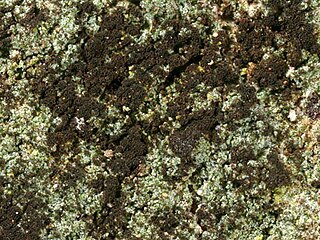
The Arthoniales is the second largest order of mainly crustose lichens, but fruticose lichens are present as well. The order contains around 1500 species, while the largest order with lichenized fungi, the Lecanorales, contains more than 14000 species.

The Arthoniaceae are a family of lichenized, lichenicolous and saprobic fungi in the order Arthoniales. The Arthoniaceae is the largest family of Arthoniales, with around 800 species. Most species in Arthoniaceae belong in Arthonia which is the largest genus with 500 species. The second and third largest genus is Arthothelium with 80 species, and Cryptothecia with 60 species.

The Graphidaceae are a family of lichen-forming fungi in the order Graphidales. The family contains nearly a hundred genera and more than 2000 species. Although the family has a cosmopolitan distribution, most Graphidaceae species occur in tropical regions, and typically grow on bark.

Porina is a genus of lichens in the family Trichotheliaceae. A 2020 estimate places about 145 species in the widespread genus.
Redingeria is a genus of lichenized fungi in the family Graphidaceae. It was circumscribed in 2006 by Andreas Frisch, with Redingeria leiostoma assigned as the type species. The genus name honours Karl Martin Redinger (1907–1940), an Austrian botanist.

Cryptothecia is a genus of white to greenish crustose lichens that grow on bark, wood, or leaves, in tropical or subtropical areas worldwide. It has a conspicuous prothallus that develops around its periphery which can be bright red in some species, hence the common name wreath lichen. The main vegetative body (thallus) lacks a cortex (ecorticate and is often immersed in the substrate or byssoid. The medulla is white, well defined, and often peppered with calcium oxalate crystals. Ascomata are not well defined, being cushions of soft white mycelium immersed in the medullary tissue, hence the name from the Greek krypto = "to conceal" and theke = "a container or sheath". It contains Trentepohlia, a green alga, as its photobiont partner.

Enterographa is a genus of lichens in the family Roccellaceae.

Felipes is a genus of lichenized fungi in the order Arthoniales. Circumscribed by Andreas Frisch and Göran Thor in 2014, it contains the single species Felipes leucopellaeus. Genetic analysis shows that the genus falls into the order Arthoniales, but its familial placement is uncertain. Felipes leucopellaeus is found across Europe and North America in temperate and boreal regions, typically in old-growth forest or wooded mires. It is crustose and corticolous.
Polymeridium is a genus of lichen-forming fungi in the family Trypetheliaceae. Species in the genus are corticolous (bark-dwelling) and typically occur in tropical areas.
Synarthonia is a genus of lichen-forming fungi in the order Arthoniales. The genus has not been placed into a family. Synarthonia was circumscribed by Swiss lichenologist Johannes Müller Argoviensis in 1891.
André Aptroot is a Dutch mycologist and lichenologist.
Calopadia cinereopruinosa is a species of corticolous (bark-dwelling) lichen in the family Pilocarpaceae. Found in the Galápagos Islands, it was described as new to science in 2011. It is characterized by its grey-black, white-pruinose apothecia and aeruginous hypothecium. This lichen usually grows on the bark of stems and twigs in the humid zones of the islands.
Sagenidiopsis isidiata is a species of corticolous (bark-dwelling) byssoid lichen in the family Arthoniaceae. Found in tropical montane rainforests throughout Central America, South America, and the Antilles, it was described as new to science in 2011. The lichen is characterised by its cream-coloured to greyish thallus and numerous pseudoisidia, which are small, cylindrical outgrowths on its surface.
Klaus Kalb is a German lichenologist and an authority on tropical lichens.

Herpothallon is a genus of crustose lichens in the family Arthoniaceae. It has about 50 species.
Myriostigma is a genus of lichens in the family Arthoniaceae. The genus was circumscribed by German lichenologist August von Krempelhuber in 1874.

Reichlingia is a genus of lichen-forming fungi in the family Arthoniaceae. It has seven species. The genus was originally circumscribed by Paul Diederich and Christoph Scheidegger in 1996, with Reichlingia leopoldii as the type, and at that time, only species. The fungus was at first thought to be a lichenicolous (lichen-dwelling) fungus, but is now considered a lichenised hyphomycete.
Gintarasia is a genus of lichen-forming fungi in the family Graphidaceae. It has seven species, all of which are found in Australia. Gintarasia species are corticolous (bark-dwelling), crustose lichens with a thelotremoid form.
Fouragea is a genus of lichen-forming fungi in the family Opegraphaceae. It has nine species.








